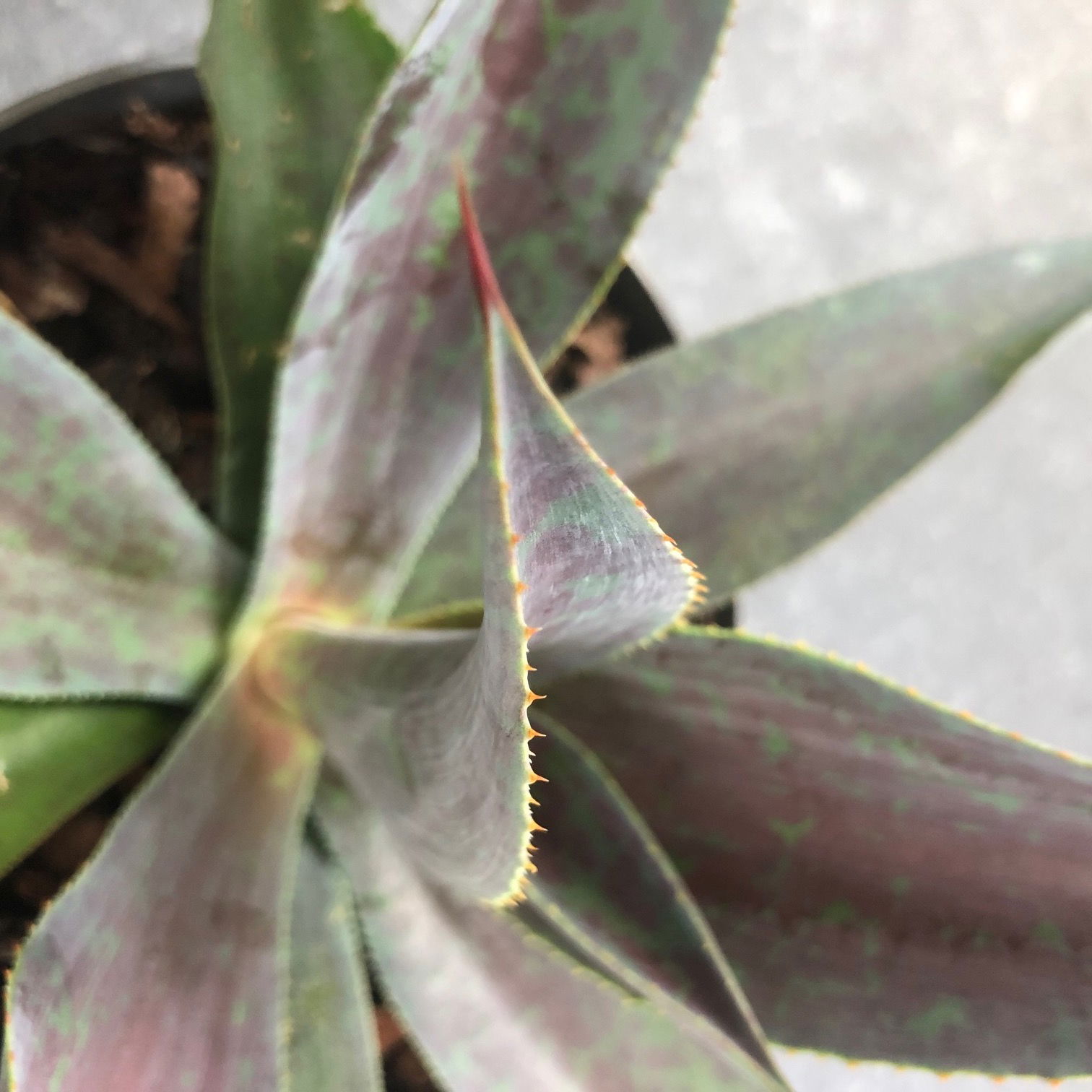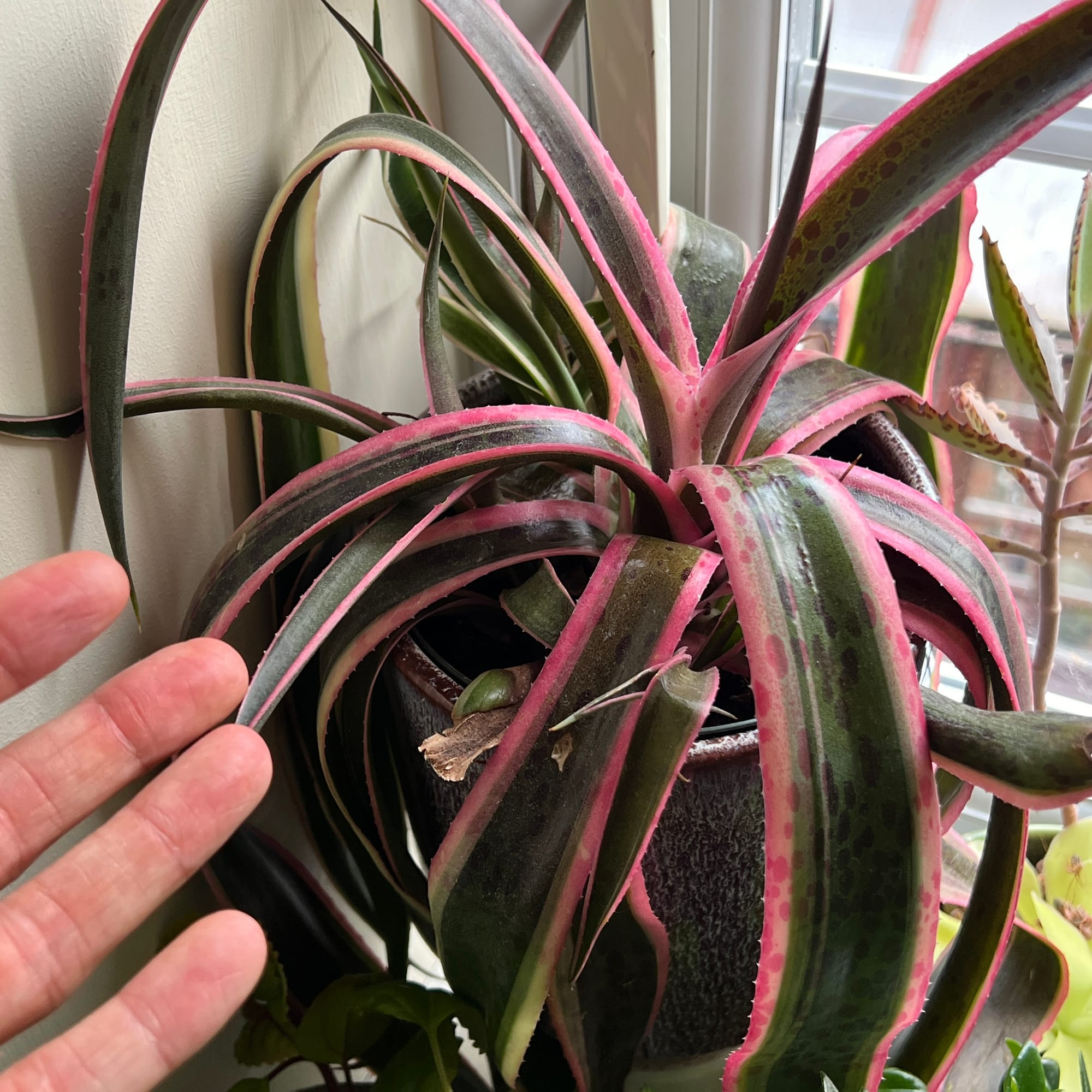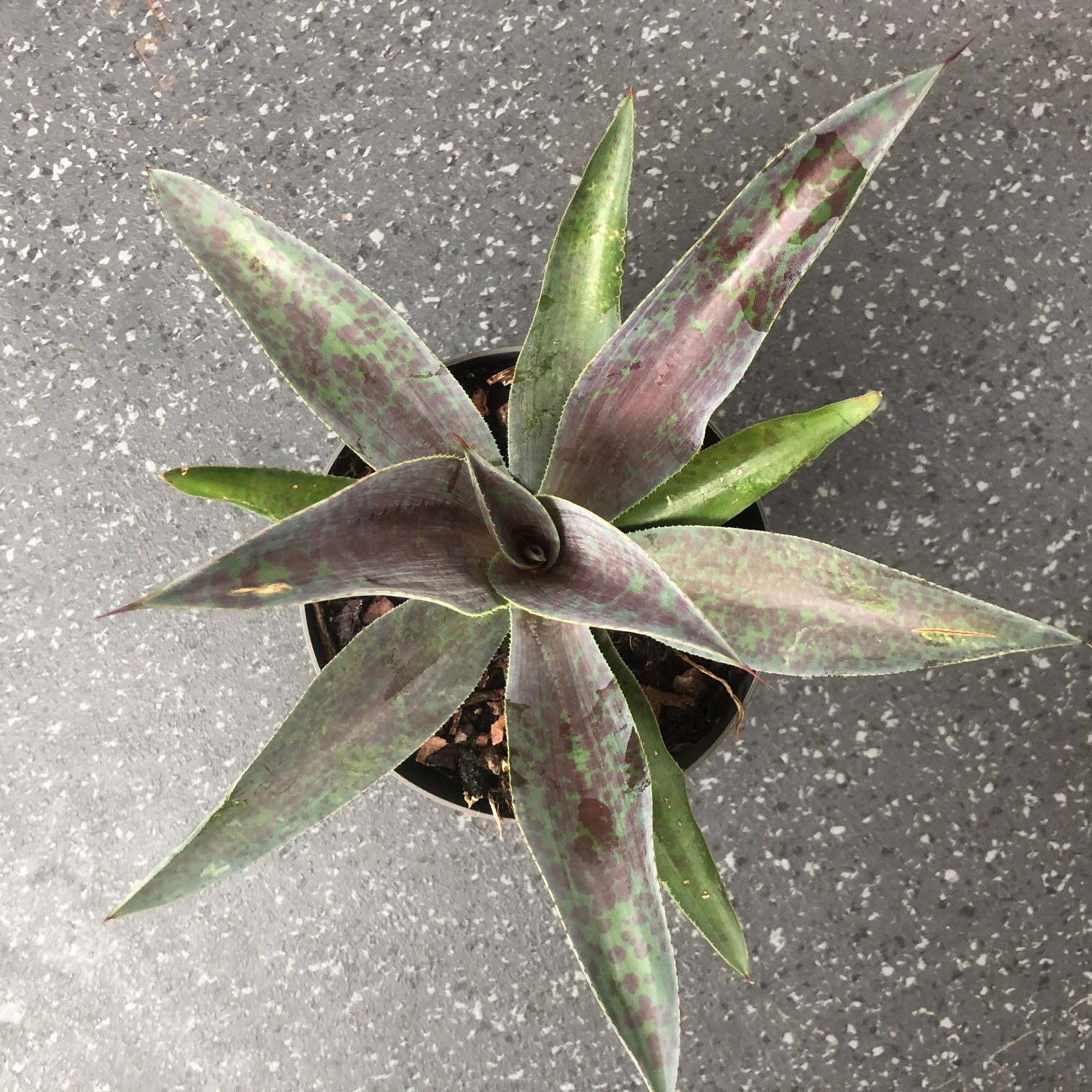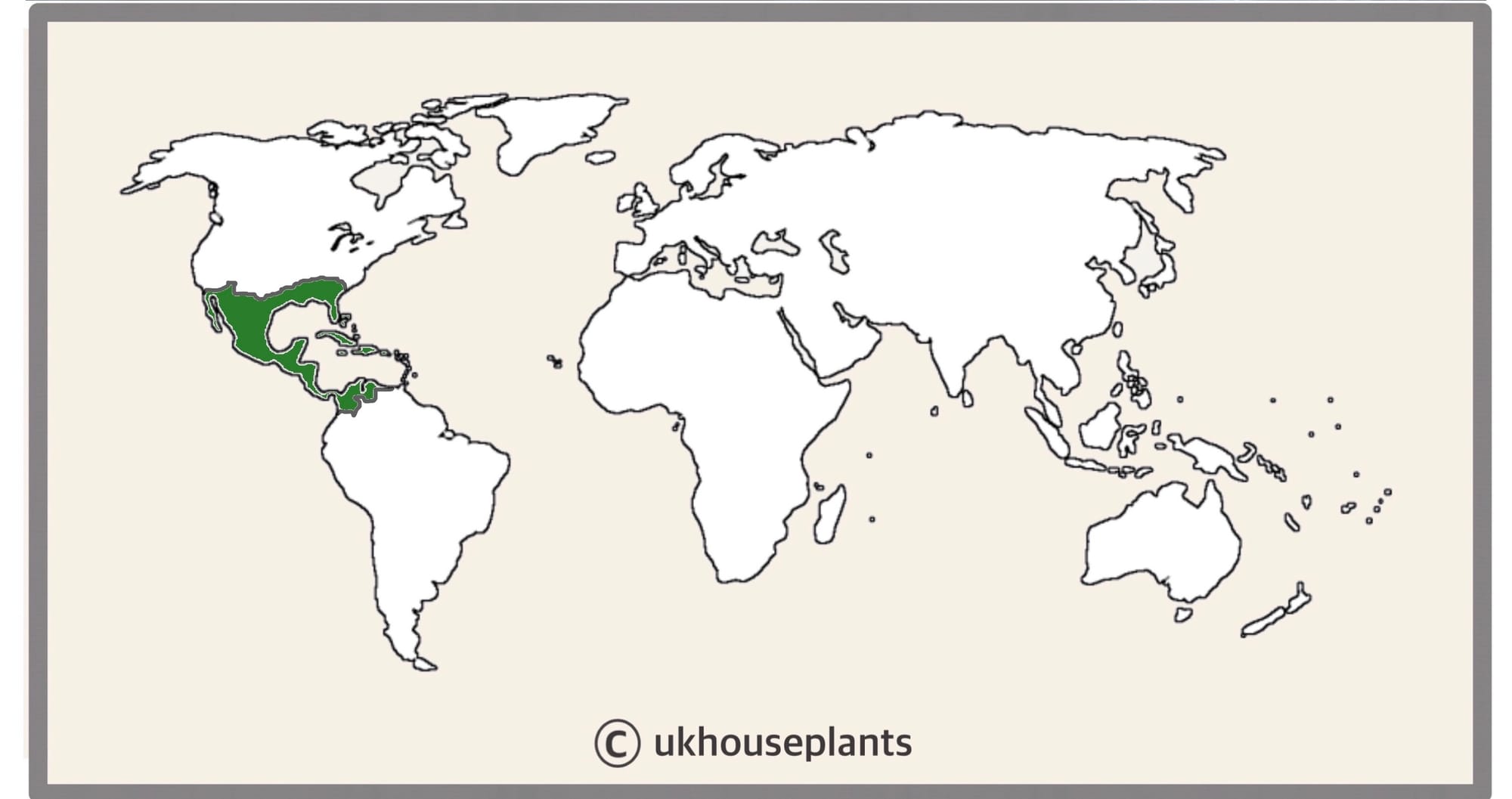
× Mangave 'Moonglow'
Contents
- Top Tips
- Location, Water, Humidity & Fertilisation
- Common Issues
- Origins, Temperature, Propagation, Repotting & Toxicity.
Need the answer to a specific plant query? Book a 1-to-1 video call with THE HOUSEPLANT DOCTOR™, the website's friendly author, to overcome and address your niggling problem! Available on iMessage, WhatsApp, Facebook Messenger & more.
Top Tips & Info
- Care Difficulty - Easy
- Provide a few hours of morning or evening sun a day.
- Allow the majority of the soil to dry out in between waters, especially during the autumn and winter months to downplay the increased risk of root rot and over-watering.
- Fertilise every two or three months using either a 'Cactus' or 'Houseplant' labelled feed.
- Yellowing lower leaves are the direct result of too little light and/or over-watering. Scroll down to ‘Common Issues’ for more information on this.
- Repot every three years using a well-draining potting mix (we'd recommend a 'Cactus & Succulent' compost) and the next sized pot with drainage holes.
Location & Light - 🔸🔸🔸
It's essential not to situate your Mangave in a location where you can't read a newspaper. Due to the slowed rates of photosynthesis and water-uptake, the risk of root rot will dramatically increase the further you travel into the shade. The ideal setting for this plant is somewhere that can offer a few hours of morning/evening sun, or at least with over-head lighting. A bright, warm conservatory is best, or within a few metres of a south-facing window. Never situate one in a north-facing room, especially in the autumn and winter months, as there won't be enough light during the day.
Water - 🔸
Mangaves will require drenches between droughts to become sufficiently hydrated. As mentioned above, there'll always be a risk of root or heart rot with those kept in too much moisture, so allow almost all of the soil dry to dry out in between waters. Under-watering symptoms include collapsed or greyed leaves, stunted growth and crisping brown edges; these issues are usually down to too much light/heat or forgetfulness but is somewhat uncommon among gardeners. If your specimen receives several hours of light a day, we'd recommend reducing the overall time by half to counteract the development of sun-scorch. Over-watering symptoms include spotty brown leaves with yellow perimeters, stunted growth and a rotten base. Mangaves will only thrive in bright settings, so locations that are too dark will significantly increase the chance of over-watering and yellowing lower leaves.
Humidity - 🔸🔸
This is not a necessity; however, a quick hose down from time to time will hydrate the leaves and wash away dust or potential pests.
Fertilisation - 🔸
Fertilise every two months during the growing period and every three months in the autumn & winter to replicate its dormancy period. Although a 'Houseplant' fertiliser will still do the job, we'd recommend using a specific 'Cactus' labelled feed as it'll support the vital thirteen nutrients that this species will need to grow.
 Mangaves are a man-made hybrid between the Agave & Manfreda back in 2005. As both parents develop thorns along their leaves' upper margins, it was wholly expected for the Mangave to adopt a similar mannerism.
Mangaves are a man-made hybrid between the Agave & Manfreda back in 2005. As both parents develop thorns along their leaves' upper margins, it was wholly expected for the Mangave to adopt a similar mannerism.
Common Issues with Mangaves
Over-watering is the biggest issue when it comes to Mangaves. Typical signs of this include brown leaves with soft spots on the underside of the leaves, basal/crown rot or a collapsed stem. Not only do you have to be mindful of root rot, but you'll also have to think about which plant parts to keep dry. The soil must have periods of droughts to imitate the habitats of arid deserts, as well as limiting the chance of root rot. Its central crown must also remain dry at all times to prevent the development of basal rot. The final over-watering heads-up is to avoid waterlogging; there's no point fulfilling the ukhouseplants' phrase, 'drenches in between droughts' if the base of the pot is submerged, as root rot will arise. For any more information about over-watering related issues, be sure to click on this link!
A pale central crown is a typical sign of too little light. As Mangaves originate in bright locations around Africa, replicate their habitats by offering at least two hours of direct sunlight a day.

Red or purple leaves on your Manage succulent are the product of too much sunlight, most common during the height of summer. A pigmentation called 'Carotenoids' will alter the appearance of your plant to counteract the harsh effects of the UV rays. This doesn't mean it'll die, it just a behaviour to keep it from burning in the sun. THE HOUSEPLANT DOCTOR™ recommends to relocate in another windowsill that offers indirect sunlight, like a north-west, north or north-east facing window.
Mould or mushrooms developing on the soil means two things - too little light and over-watering. Despite the harmlessness, it'll prove unsightly to most gardeners and is therefore removed once known. To remove, replace the top two inches of the soil for a fresh batch of 'Cactus & Succulent' compost. Either increase the amount of light received (no direct sunlight for the first few weeks to prevent environmental shock) or decrease the frequency of waters slightly. If the mould is accompanied by yellowing lower leaves, you may also have a case of root rot.

× Mangave 'Mission to Mars'
Origins
Mangaves don't naturally occur in the wild as the genus is a human-made hybrid. Its parents, the Agave and Manfreda, have been formally documented in texts or books since the eighteenth century, with both originating from the central south of North America. Subsequently, all species within Manfreda have now been moved into the genus of Agave, after extensive genetic testing.
 The Distribution of Agave & Manfreda (its parent plants).
The Distribution of Agave & Manfreda (its parent plants).
Temperature
8° - 32°C (46° - 90°F)
H1c (Hardiness Zone 11) - Can be grown outdoors between late spring and summer throughout most of the UK while nighttime temperatures are above 10℃ (50℉). If you decide to bring the plant outdoors, don't allow it to endure more than an hour of direct sunlight a day as it may result in sun-scorch. Regularly keep an eye out for pests, especially when re-introducing back indoors.
Spread
Up to 0.4m in height and 0.4m in width once they reach maturity. The ultimate height will take between 5 - 10 years to achieve, with 5cm of growth being put out per year.
Pruning & Maintenance
Remove yellow or dying leaves, and plant debris to encourage better-growing conditions. While pruning, always use clean utensils or shears to reduce the chance of bacterial and fungal diseases. Never cut through yellowed tissue as this may cause further damage in the likes of diseases or bacterial infections. Remember to make clean incisions as too-damaged wounds may shock the plant, causing weakened growth and a decline in health.
Propagation
Via Seeds & Basal Offsets (Pups).
Basal Offset Division (Easy) - Your plant will produce several basal offsets that can be separated once they have a sufficient root system, and surpass 4cm (1.5 inches) in width & height. If possible, water the soil 24hrs before the main event to reduce the risk of transplant shock when its dry root systems are over-fingered. Take the plant out of its pot and place your fingers close to the nodal junction - compost may have to be removed for better access. Push the chosen offset downwards until you hear a snap. Separate the foliage and its root system away from the mother plant, mentally noting the high risk of damage. Transplant in the appropriate sized pot with a fresh batch of 'Cactus & Succulent' labelled soil. Maintain evenly moist soil and situate it in a bright, indirect location away from any direct sunlight for the first six weeks. After this period, treat it like a mature specimen, following the care tips above!
Flowers
The chance of a Mangave producing a flower will be highly unlikely due to the unfavoured growing conditions indoors. If the specimen does flower though, a thick tubular stalk will develop during late spring, producing a show of colour for several weeks. The 60cm (2ft) spike will produce clusters of yellow, pink, red or white flowers along the shaft, forming a tree-like structure.
If pollinated successfully, the seeds can take several months to develop and can be propagated in the following spring. Its parent plant, the Agave, is mostly monocarpic, meaning that the specimen will die shortly after flowering - it is still unknown whether Managves follow this same pattern.
 In some cases, your Mangave may produce a separate plant on the tip of its flower-spike that can be propagated by placing the little plantlet's base in a 5cm pot of 'Cactus & Succulent potting mix! Credit: Our reader, Mary.
In some cases, your Mangave may produce a separate plant on the tip of its flower-spike that can be propagated by placing the little plantlet's base in a 5cm pot of 'Cactus & Succulent potting mix! Credit: Our reader, Mary.
Repotting
Repot every two to three years in spring using a 'Cactus & Succulent' labelled potting mix and the next sized pot with adequate drainage. Mangaves are a 'family plant' and therefore the mother plant can happily grow with its pups for many years, even if this means over-filling the pot. They prefer to be potbound as this will downplay the risk of over-watering (& root rot), so only repot if necessary or if you're interested in propagating the offsets to expand your spiky collection.
If you were to repot your Mangave, hydrate the soil 24hrs before tinkering with the roots to prevent the risk of transplant shock. Use a 'Cactus & Succulent' labelled potting mix and the next sized pot, unless the rootball is significantly reduced due to the propagation of pups. We recommend using a terracotta pot as this will help with drainage and moisture absorption.
Book a 1-to-1 video call with Joe Bagley if you'd like a personal guide to repotting your houseplant. This will include recommending the right branded-compost and pot size, followed by a live video call whilst you transplant the specimen for step-by-step guidance and answer any further questions!
Pests & Diseases
Keep an eye out for mealybugs, scale, thrips, whitefly, caterpillars & vine weevils. Typical diseases associated with Mangaves are root rot, heart rot, leaf-spot disease, botrytis (grey mould) & powdery mildew - click here to learn about these issues.
Toxicity
Not known to be poisonous when consumed by pets and humans. If large quantities are eaten, it may result in vomiting, nausea and a loss of appetite. Please note that the leaves' edges are razor-sharp, so always wear protective gloves when handling.
Retail Locations
Walter Gardens & Online Stores.
Book a 1-to-1 Call with Joe Bagley
If you need further advice with your houseplants, book an advice call with ukhouseplants' friendly and expert writer today! This can be done via a video or audio call on most apps, including Facebook, FaceTime & Skype. A ten-minute call costs £3.99 (US$5), or £14.99 for thirty minutes. You can ask multiple questions, including queries on plants, pests, terrariums, repotting advice and anything in between. Please consider supporting this service to keep ukhouseplants thriving!